Leveraging the No Net Land Take Policy through Ecological Connectivity Analysis: The Role of Industrial Platforms in Flanders, Belgium
Abstract
:1. Introduction
1.1. Infrastructures and Bouwshift
1.2. Background Flanders Region
2. Materials and Methods
2.1. Patch–Corridor–Matrix Model
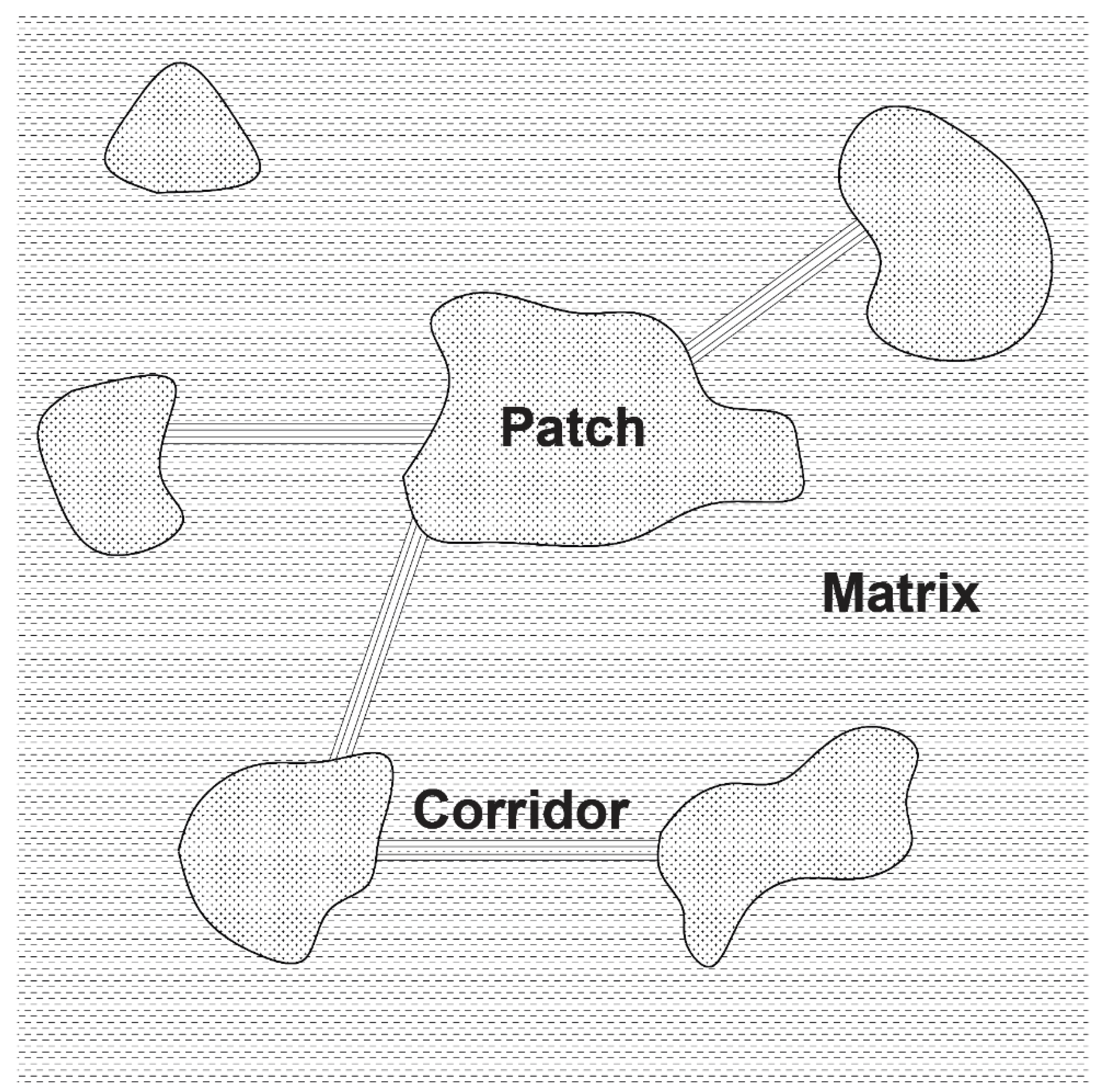
2.2. Multifunctionality Framework for Assessing GI Planning
3. Results
3.1. The Ecological Network Analysis of Flanders
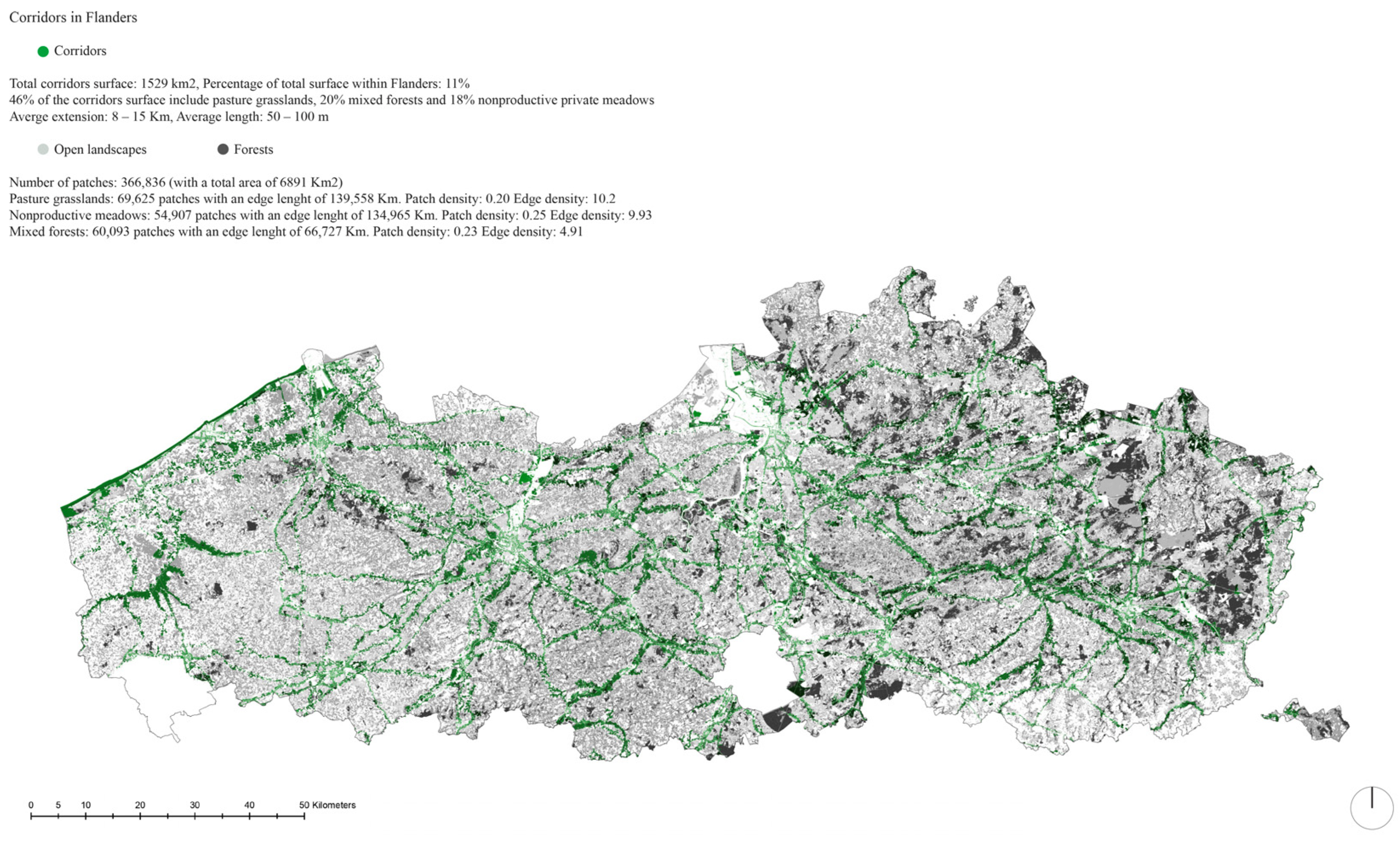

3.2. Ecological Network Analysis of the Industrial Platforms
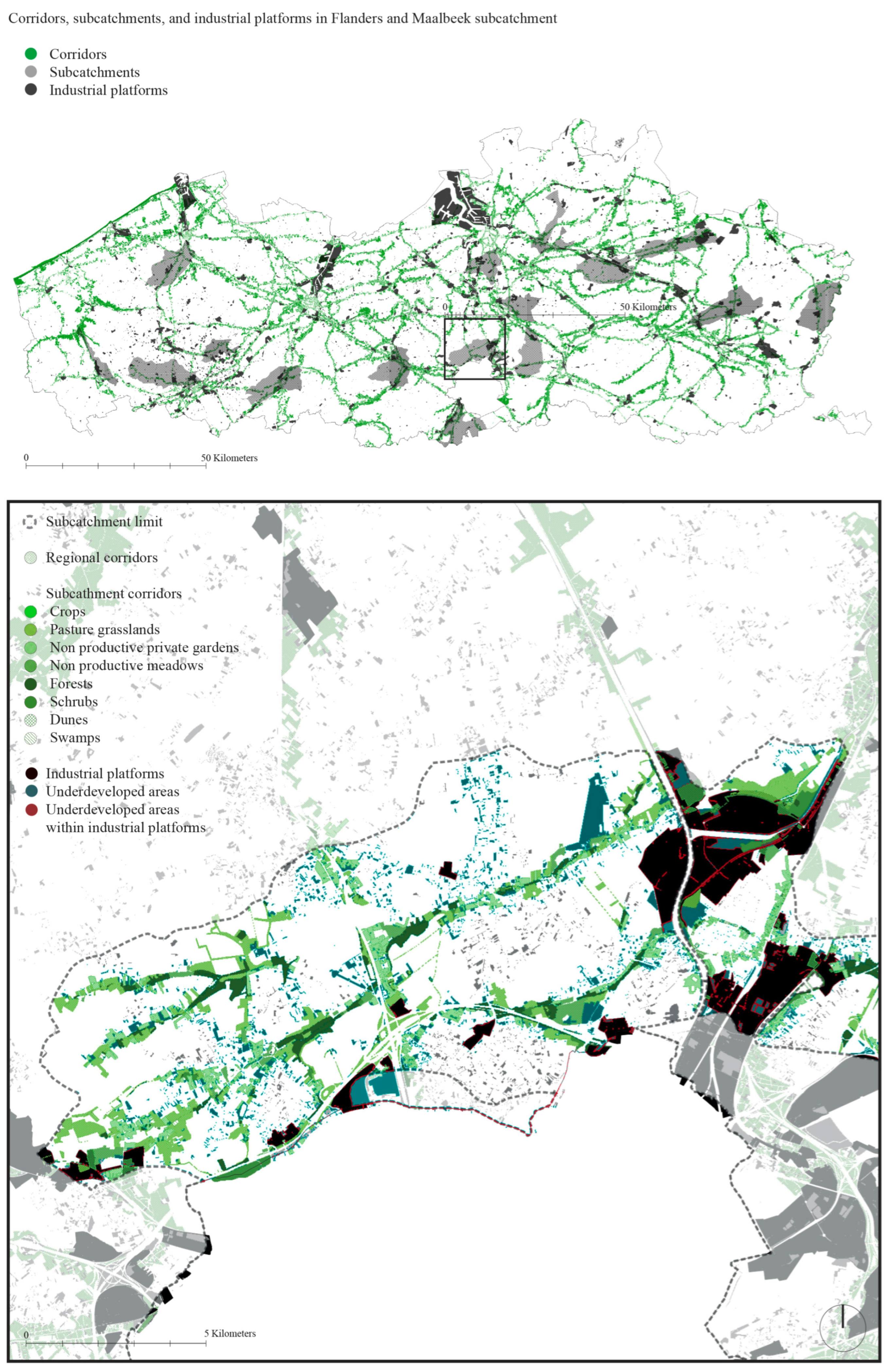
4. Discussion
5. Conclusions
Author Contributions
Funding
Institutional Review Board Statement
Informed Consent Statement
Data Availability Statement
Acknowledgments
Conflicts of Interest
References
- Piper, J. Revising green infrastructure: Concepts between nature and design, by Daniel Czechowski, Thomas Hauck and Georg Hausladen, Boca Raton, FL, CRC Press, 2015, xxiv + 464 pp., £89.00 (hardback), ISBN 978-1-4822-3220-2. Int. J. Urban Sustain. Dev. 2015, 7, 245–247. [Google Scholar] [CrossRef]
- Perrotti, D. Landscape as Energy Infrastructure: Ecologic Approaches and Aesthetic Implications of Design. In Revising Green Infrastructure; CRC Press: Boca Raton, FL, USA, 2014; pp. 71–90. [Google Scholar] [CrossRef]
- Rodríguez-Espinosa, V.M.; Aguilera-Benavente, F.; Gómez-Delgado, M. Green infrastructure design using GIS and spatial analysis: A proposal for the Henares Corridor (Madrid-Guadalajara, Spain). Landsc. Res. 2020, 45, 26–43. [Google Scholar] [CrossRef]
- Perrotti, D.; Iuorio, O. Green Infrastructure in the Space of Flows: An Urban Metabolism Approach to Bridge Environmental Performance and User’s Wellbeing. In Cities and Nature; The Nature Conservancy: Arlington County, VA, USA, 2019; pp. 265–277. [Google Scholar] [CrossRef]
- Artmann, M.; Bastian, O.; Grunewald, K. Using the Concepts of Green Infrastructure and Ecosystem Services to Specify Leitbilder for Compact and Green Cities—The Example of the Landscape Plan of Dresden (Germany). Sustainability 2017, 9, 198. [Google Scholar] [CrossRef]
- Brueckner, J.K. Urban Sprawl: Diagnosis and Remedies. Int. Reg. Sci. Rev. 2000, 23, 160–171. [Google Scholar] [CrossRef]
- Liquete, C.; Kleeschulte, S.; Dige, G.; Maes, J.; Grizzetti, B.; Olah, B.; Zulian, G. Mapping green infrastructure based on ecosystem services and ecological networks: A Pan-European case study. Environ. Sci. Policy 2015, 54, 268–280. [Google Scholar] [CrossRef]
- Kalantari, Z.; Santos Ferreira, C.S.; Page, J.; Goldenberg, R.; Olsson, J.; Destouni, G. Meeting sustainable development challenges in growing cities: Coupled social-ecological systems modeling of land use and water changes. J. Environ. Manag. 2019, 245, 471–480. [Google Scholar] [CrossRef]
- Schiavina, M.; Melchiorri, M.; Corbane, C.; Florczyk, A.; Freire, S.; Pesaresi, M.; Kemper, T. Multi-Scale Estimation of Land Use Efficiency (SDG 11.3.1) across 25 Years Using Global Open and Free Data. Sustainability 2019, 11, 5674. [Google Scholar] [CrossRef]
- Maes, J.; Liquete, C.; Teller, A.; Erhard, M.; Paracchini, M.L.; Barredo, J.I.; Grizzetti, B.; Cardoso, A.; Somma, F.; Petersen, J.-E.; et al. An indicator framework for assessing ecosystem services in support of the EU Biodiversity Strategy to 2020. Ecosyst. Serv. 2016, 17, 14–23. [Google Scholar] [CrossRef]
- Cortinovis, C.; Haase, D.; Zanon, B.; Geneletti, D. Is urban spatial development on the right track? Comparing strategies and trends in the European Union. Landsc. Urban Plan. 2019, 181, 22–37. [Google Scholar] [CrossRef]
- Decoville, A.; Schneider, M. Can the 2050 zero land take objective of the EU be reliably monitored? A comparative study. J. Land Use Sci. 2015, 1–19. [Google Scholar] [CrossRef]
- Lacoere, P.; Leinfelder, H. No Net Land Take for Flanders. Towards a Roadmap for the Implementation of Europe’s Land Target; oekom verlag GmbH: München, Germany, 2023; pp. 1–16. [Google Scholar]
- Buitelaar, E.; Leinfelder, H. Public Design of Urban Sprawl: Governments and the Extension of the Urban Fabric in Flanders and the Netherlands. Urban Plan. 2020, 5, 46–57. [Google Scholar] [CrossRef]
- Jayasooriya, V.M.; Muthukumaran, S.; Ng, A.W.M.; Perera, B.J.C. Multi Criteria Decision Making in Selecting Stormwater Management Green Infrastructure for Industrial areas Part 2: A Case Study with TOPSIS. Water Resour. Manag. 2018, 32, 4297–4312. [Google Scholar] [CrossRef]
- Schippa, G.; Interlandi, S.; Russo, P.; Branca, F. Green restoration of the industrial area of the city of Catania for improving urban resilience and sustainability. Acta Hortic. 2018, 307–310. [Google Scholar] [CrossRef]
- Gavrilov, O.E.; Eremeeva, S.S.; Karaganova, N.G.; Kazakov, A.V.; Mironov, A.A. Ecological activity area formation of an industrial enterprise: Applied aspects. IOP Conf. Ser. Earth Environ. Sci. 2021, 677, 052059. [Google Scholar] [CrossRef]
- Jayasooriya, V.M.; Ng, A.W.M.; Muthukumaran, S.; Perera, C.B.J. Optimization of Green Infrastructure Practices in Industrial Areas for Runoff Management: A Review on Issues, Challenges and Opportunities. Water 2020, 12, 1024. [Google Scholar] [CrossRef]
- Sacirovic, S.; Ketin, S.; Vignjevic, N. Eco-industrial zones in the context of sustainability development of urban areas. Environ. Sci. Pollut. Res. 2019, 26, 24346–24356. [Google Scholar] [CrossRef]
- Zaykova, E.Y. Postindustrial Space: Integration of Green Infrastructure in the Center, Middle and Periphery of the City. In Springer Geography; Springer: Cham, Switzerland, 2018; pp. 106–117. [Google Scholar]
- Population Belgium. Available online: https://statbel.fgov.be/en/themes/population/structure-population (accessed on 16 September 2022).
- Davids, P.; Boelens, L.; Tempels, B. The effects of tailor-made flood risk advice for homeowners in Flanders, Belgium. Water Int. 2019, 44, 539–553. [Google Scholar] [CrossRef]
- Crabbé, A.; Coppens, T. Swapping Development Rights in Swampy Land: Strategic Instruments to Prevent Floodplain Development in Flanders. In Nature-Based Flood Risk Management on Private Land; Springer International Publishing: Cham, Switzerland, 2019; pp. 85–97. ISBN 9783030238421. [Google Scholar]
- Hansen, R.; Pauleit, S. From Multifunctionality to Multiple Ecosystem Services? A Conceptual Framework for Multifunctionality in Green Infrastructure Planning for Urban Areas. Ambio 2014, 43, 516–529. [Google Scholar] [CrossRef]
- Forman, R.T.T. Some general principles of landscape and regional ecology. Landsc. Ecol. 1995, 10, 133–142. [Google Scholar] [CrossRef]
- Perrotti, D. Revising Green Infrastructure; CRC Press: Boca Raton, FL, USA, 2018. [Google Scholar] [CrossRef]
- Chang, Q.; Li, X.; Huang, X.; Wu, J. A GIS-based Green Infrastructure Planning for Sustainable Urban Land Use and Spatial Development. Procedia Environ. Sci. 2012, 12, 491–498. [Google Scholar] [CrossRef]
- Eisenman, T.S. Book Review: The Ecological Design and Planning Reader. J. Plan. Educ. Res. 2017, 37, 374–376. [Google Scholar] [CrossRef]
- Heckert, M.; Rosan, C.D. Creating GIS-Based Planning Tools to Promote Equity Through Green Infrastructure. Front. Built Environ. 2018, 4, 27. [Google Scholar] [CrossRef]
- Otero Peña, D.; Perrotti, D.; Mohareb, E. Advancing urban metabolism studies through GIS data: Resource flows, open space networks, and vulnerable communities in Mexico City. J. Ind. Ecol. 2022, 26, 1333–1349. [Google Scholar] [CrossRef]
- Rall, E.; Hansen, R.; Pauleit, S. The added value of public participation GIS (PPGIS) for urban green infrastructure planning. Urban For. Urban Green. 2019, 40, 264–274. [Google Scholar] [CrossRef]
- Nieuwenhuijsen, M.J. Green Infrastructure and Health. Annu. Rev. Public Health 2021, 42, 317–328. [Google Scholar] [CrossRef]
- Babí Almenar, J.; Elliot, T.; Rugani, B.; Philippe, B.; Navarrete Gutierrez, T.; Sonnemann, G.; Geneletti, D. Nexus between nature-based solutions, ecosystem services and urban challenges. Land Use Policy 2021, 100, 104898. [Google Scholar] [CrossRef]
- Marando, F.; Heris, M.P.; Zulian, G.; Udías, A.; Mentaschi, L.; Chrysoulakis, N.; Parastatidis, D.; Maes, J. Urban heat island mitigation by green infrastructure in European Functional Urban Areas. Sustain. Cities Soc. 2022, 77, 103564. [Google Scholar] [CrossRef]
- Kabisch, N.; Korn, H.; Stadler, J.; Bonn, A. Nature-Based Solutions to Climate Change Adaptation in Urban Areas—Linkages Between Science, Policy and Practice; Springer: Cham, Switzerland, 2017; pp. 1–11. [Google Scholar]
- Mosleh, L.; Negahban-Azar, M.; Pavao-Zuckerman, M. Stormwater Green Infrastructure Resilience Assessment: A Social-Ecological Framework for Urban Stormwater Management. Water 2023, 15, 1786. [Google Scholar] [CrossRef]
- Voghera, A.; Giudice, B. Evaluating and Planning Green Infrastructure: A Strategic Perspective for Sustainability and Resilience. Sustainability 2019, 11, 2726. [Google Scholar] [CrossRef]
- Hansen, R.; Olafsson, A.S.; van der Jagt, A.P.N.; Rall, E.; Pauleit, S. Planning multifunctional green infrastructure for compact cities: What is the state of practice? Ecol. Indic. 2019, 96, 99–110. [Google Scholar] [CrossRef]
- Dennis, M.; Barker, A.; Anderson, J.; Ashton, J.C.; Cavan, G.; Cook, P.A.; French, D.; Gilchrist, A.; James, P.; Phillipson, C.; et al. Integrating knowledge on green infrastructure, health and well-being in ageing populations: Principles for research and practice. Ambio 2023, 52, 107–125. [Google Scholar] [CrossRef] [PubMed]
- Haines-Young, R.; Potschin, M. Common International Classification of Ecosystem Goods and Services (CICES): Consultation on Version 4, August-December 2012; EEA Framework Contract No EEA/IEA/09/003; Contract: København, Denmark, 2010. [Google Scholar]
- Mathey, J.; Rößler, S.; Banse, J.; Lehmann, I.; Bräuer, A. Brownfields As an Element of Green Infrastructure for Implementing Ecosystem Services into Urban Areas. J. Urban Plan. Dev. 2015, 141. [Google Scholar] [CrossRef]
- La Rosa, D.; Spyra, M.; Inostroza, L. Indicators of Cultural Ecosystem Services for urban planning: A review. Ecol. Indic. 2016, 61, 74–89. [Google Scholar] [CrossRef]
- Ziter, C. The biodiversity–ecosystem service relationship in urban areas: A quantitative review. Oikos 2016, 125, 761–768. [Google Scholar] [CrossRef]
- Otsuka, N.; Abe, H.; Isehara, Y.; Miyagawa, T. The potential use of green infrastructure in the regeneration of brownfield sites: Three case studies from Japan’s Osaka Bay Area. Local Environ. 2021, 26, 1346–1363. [Google Scholar] [CrossRef]
- Gyurkovich, M.; Gyurkovich, J. New Housing Complexes in Post-Industrial Areas in City Centres in Poland Versus Cultural and Natural Heritage Protection—With a Particular Focus on Cracow. Sustainability 2021, 13, 418. [Google Scholar] [CrossRef]
- Kristiánová, K.; Gécová, K.; Putrová, E. Old Industrial Sites—Conversion to Parks: Potential of Bratislava. Procedia Eng. 2016, 161, 1858–1862. [Google Scholar] [CrossRef]
- Draus, P.; Lovall, S.; Formby, T.; Baldwin, L.; Lowe-Anderson, W. A green space vision in Southeast Michigan’s most heavily industrialized area. Urban Ecosyst. 2019, 22, 91–102. [Google Scholar] [CrossRef]
- Venkataramanan, V.; Packman, A.I.; Peters, D.R.; Lopez, D.; McCuskey, D.J.; McDonald, R.I.; Miller, W.M.; Young, S.L. A systematic review of the human health and social well-being outcomes of green infrastructure for stormwater and flood management. J. Environ. Manag. 2019, 246, 868–880. [Google Scholar] [CrossRef]
- Marques, B.; McIntosh, J.; Chanse, V. Improving Community Health and Wellbeing Through Multi-Functional Green Infrastructure in Cities Undergoing Densification. Acta Hortic. Regiotect. 2020, 23, 101–107. [Google Scholar] [CrossRef]
- Panagopoulos, T. Special Issue: Landscape Urbanism and Green Infrastructure. Land 2019, 8, 112. [Google Scholar] [CrossRef]
- Grommen, C.; Aragone, A.; Notteboom, B. Actions for Water. In A Thousand Water Towers for Flanders; Report for Departement Omgeving; Vlaamse Overheid: Brussels, Belgium, 2022. [Google Scholar]
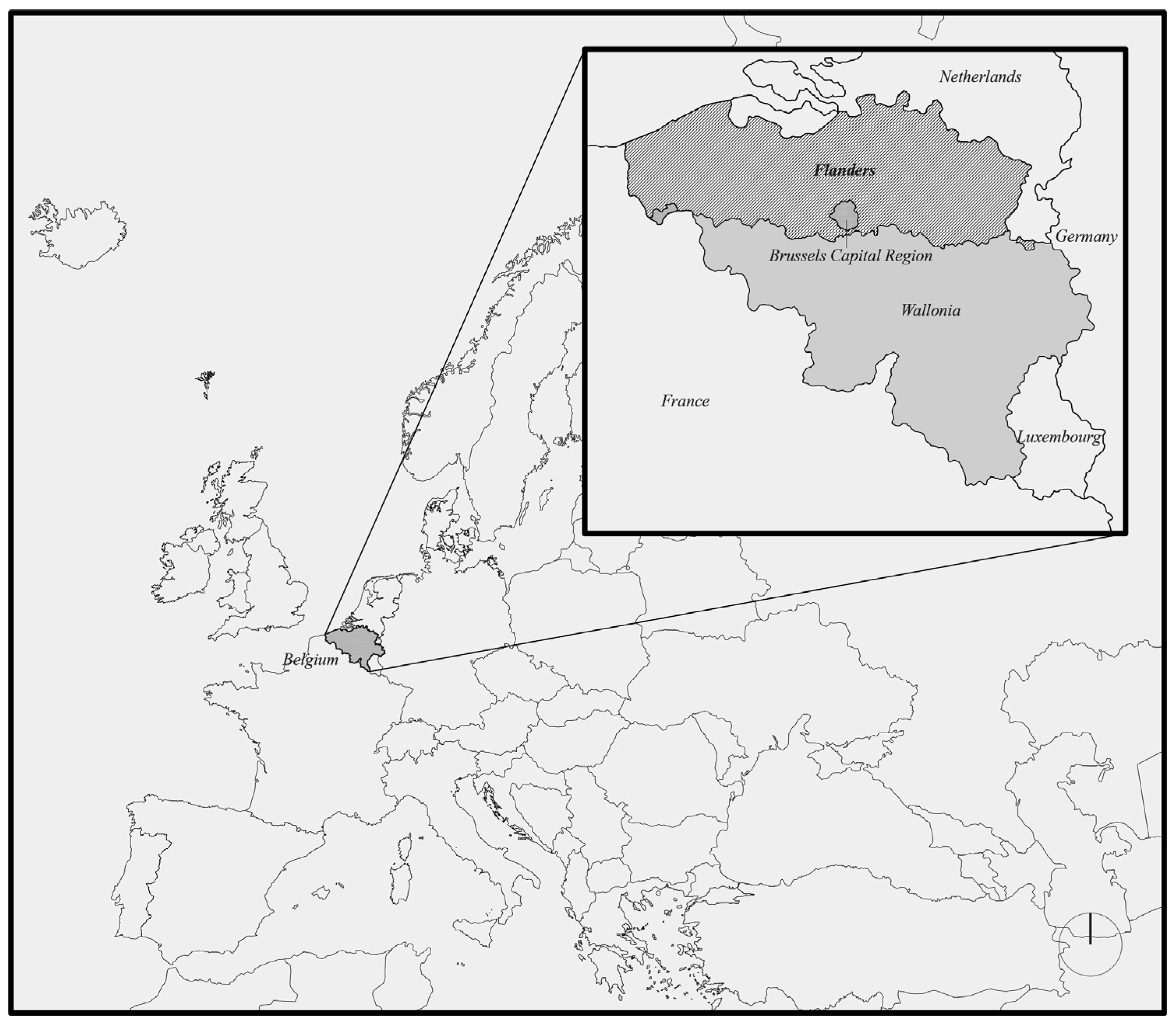
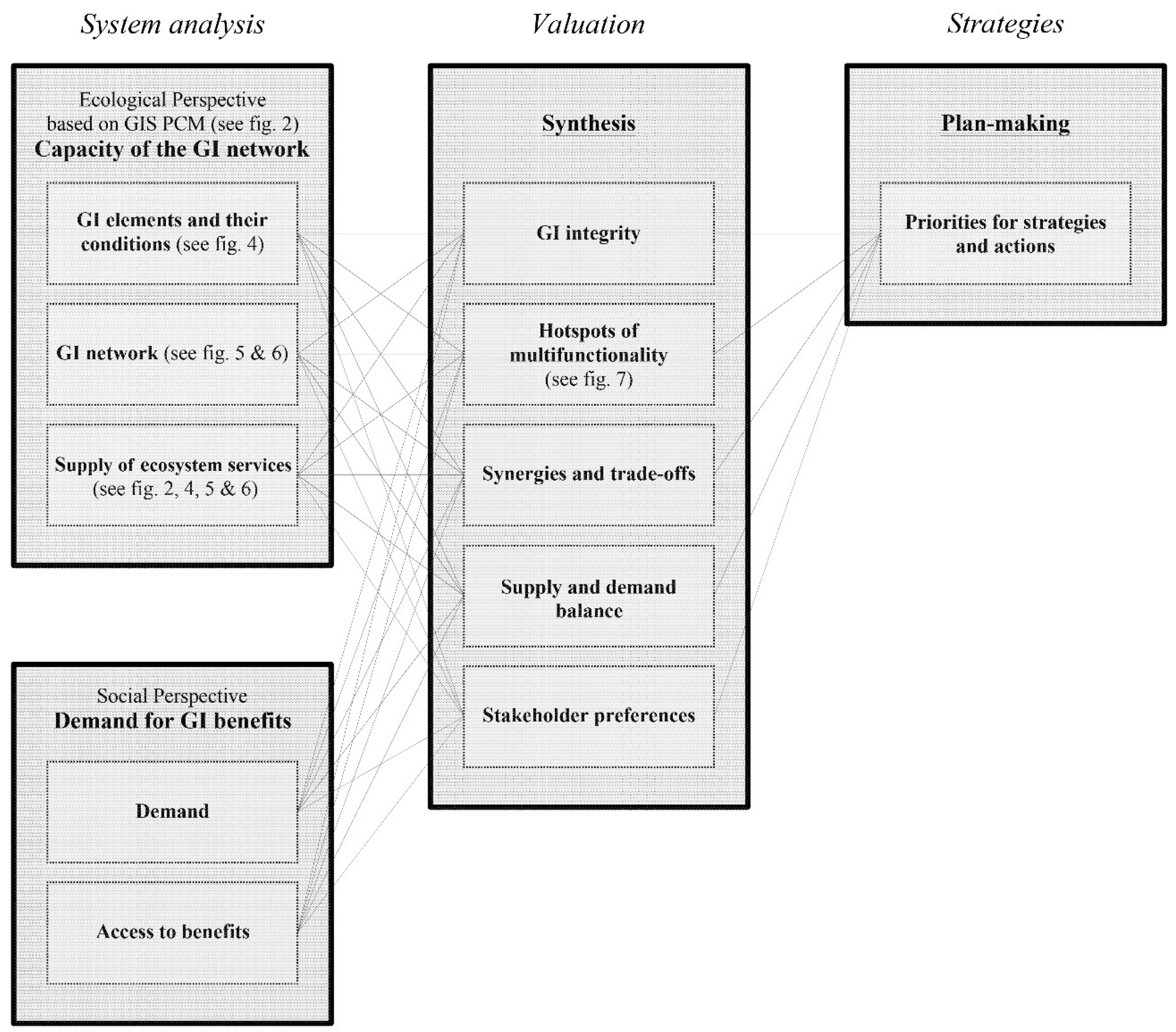

Disclaimer/Publisher’s Note: The statements, opinions and data contained in all publications are solely those of the individual author(s) and contributor(s) and not of MDPI and/or the editor(s). MDPI and/or the editor(s) disclaim responsibility for any injury to people or property resulting from any ideas, methods, instructions or products referred to in the content. |
© 2023 by the authors. Licensee MDPI, Basel, Switzerland. This article is an open access article distributed under the terms and conditions of the Creative Commons Attribution (CC BY) license (https://creativecommons.org/licenses/by/4.0/).
Share and Cite
Nalumu, D.J.; Peña, D.O.; Perrotti, D. Leveraging the No Net Land Take Policy through Ecological Connectivity Analysis: The Role of Industrial Platforms in Flanders, Belgium. Sustainability 2023, 15, 16103. https://doi.org/10.3390/su152216103
Nalumu DJ, Peña DO, Perrotti D. Leveraging the No Net Land Take Policy through Ecological Connectivity Analysis: The Role of Industrial Platforms in Flanders, Belgium. Sustainability. 2023; 15(22):16103. https://doi.org/10.3390/su152216103
Chicago/Turabian StyleNalumu, Dorothy Julian, Daniel Otero Peña, and Daniela Perrotti. 2023. "Leveraging the No Net Land Take Policy through Ecological Connectivity Analysis: The Role of Industrial Platforms in Flanders, Belgium" Sustainability 15, no. 22: 16103. https://doi.org/10.3390/su152216103
APA StyleNalumu, D. J., Peña, D. O., & Perrotti, D. (2023). Leveraging the No Net Land Take Policy through Ecological Connectivity Analysis: The Role of Industrial Platforms in Flanders, Belgium. Sustainability, 15(22), 16103. https://doi.org/10.3390/su152216103






